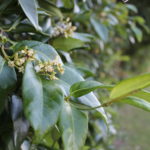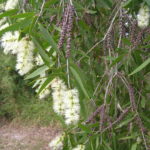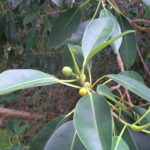The hind dunes are home to a greater variety of plants than the foredunes, because the soil is more fertile, there is shelter from salty winds and there are wetter areas in the swales.
Grasses and sedges |
 Blady grass, Imperata cylindrica Blady grass, Imperata cylindricaThis is a tall tufted grass with very sharp, minutely-toothed leaves that can easily cut an unwary weeder. It spreads by underground rhizomes but also bears silky white seed-heads.More information here and here. |
Creepers and climbers |
 Monkey rope vine, Parsonsia straminea Monkey rope vine, Parsonsia stramineaA robust vine that can climb high into trees, clinging to the branches via adventitious roots. Its 5-petalled flowers produce cigar-shaped pods which release hair-covered seeds.More information here and here. |
Herbs |
 Shepherd’s crook orchid, Geodorum densiflorum Shepherd’s crook orchid, Geodorum densiflorumA terrestrial orchid with broad, pleated leaves and a drooping stem that bears pink flowers. These produce bulbous seed capsules. Over winter, the leaves die back and the orchid remains dormant.More information here and here. |
 Bracken fern, Pteridium esculentum Bracken fern, Pteridium esculentumA hardy fern which spreads via underground rhizomes. These rhizomes were used as food by indigenous Australians, after pounding and roasting. This process removed toxins, including the carcinogen ptaquiloside.More information here, here and here. |
 Mat rush, Lomandra longifolia Mat rush, Lomandra longifoliaThis clumping plant has strap-like leaves and a flower-head that has sharp spikes distributed through it.More information here and here. |
Shrubs |
 Midyim, Austromyrtus dulcis Midyim, Austromyrtus dulcisThis sprawling shrub is the source of one of our most accessible bush foods – the midyim berry. The plant has small leaves and the 5-petalled white flowers are followed by the berries which are grey with purple flecks.More information here and here. |
Trees |
 Macaranga, Macaranga tanarius Macaranga, Macaranga tanariusEasily identified by the size and shape of its leaves, this is a common pioneer plant. The leaf veins are prominent and are often reddish. There are separate male and female plants. The yellow flowers are followed by green seed capsules covered in soft spikes.More information here, here and here. |
 Beach bird’s eye, Alectryon coriaceous Beach bird’s eye, Alectryon coriaceousProbably the most common tree on the hind-dunes, this plant has leaves that are glossy green above and greyish green below. The small yellow flowers are followed by lobed fruit that split to reveal a black seed enclosed in a fleshy red aril.More information here and here |
 Tuckeroo, Cupaniopsis anacardioides Tuckeroo, Cupaniopsis anacardioidesYoung Tuckeroos are easily mistaken for Beach bird’s eye. One difference lies in the number of leaflets in the compound leaf:- 2 to 4 in Beach bird’s eye, 4 to 11 in Tuckeroo. The fruit is firm and orange when ripe, splitting to reveal black seeds in an orange aril.More information here and here. |
 Bribie Island cypress, Callitris columellaris Bribie Island cypress, Callitris columellarisThese trees are usually among the tallest on the hind-dunes. They have a typical cypress appearance and bear spherical woody cones. Where there are stands of these trees the ground is often covered in a blanket of shed leaves.More information here and here. |
 Broad-leaved paperbark, Melaleuca quinquenervia Broad-leaved paperbark, Melaleuca quinquenerviaFound in moist swales, this tree is easily identified by its papery bark, tough flat leaves and the remnants of seed capsules along its branches. The white flowers are typical Melaleuca bottlebrushes.More information here and here. |
 Moreton Bay ash, Corymbia tessellaris Moreton Bay ash, Corymbia tessellarisThe distinctive feature of this tree is that the lower part of the trunk has rough bark, which is not shed, while the rest is smooth and is shed annually. It has narrow, curved leaves and the flowers are white.More information here and here. |
 Cheese tree, Glochidion ferdinandi Cheese tree, Glochidion ferdinandiNamed for the shape of its fruit, which resembles a small, round cheese, this is a small tree with glossy leaves.More information here and here. |
 Port Jackson fig, Ficus rubiginosa Port Jackson fig, Ficus rubiginosaAlso known as Rock fig, this grows to a tall tree with a buttressed trunk and aerial roots. The sap is milky, and the large leaves are glossy green. The fruit is orange when ripe and usually has a warty surface.More information here and here. |
 Cotton tree, Hibiscus tiliaceus Cotton tree, Hibiscus tiliaceusStands of these trees, with their sprawling branches, often form impenetrable barriers near coastal streams. They have heart-shaped leaves and yellow, typical hibiscus flowers with a dark centre.More information here. |
 Quinine berry, Petalostigma pubescens Quinine berry, Petalostigma pubescensThis is a small tree with furrowed bark and small oval leaves. Male and female flowers are borne on separate trees. The grape-sized fruit is orange when ripe and has a very bitter taste.More information here and here. |
 Coastal Canthium, Cyclophyllum coprosmoidesThis is a small tree easily identified by its dark green oval leaves and five-petalled, star-shaped white flowers.The flowers are followed by berries which are orange to red when ripe.More information here. Coastal Canthium, Cyclophyllum coprosmoidesThis is a small tree easily identified by its dark green oval leaves and five-petalled, star-shaped white flowers.The flowers are followed by berries which are orange to red when ripe.More information here. |
